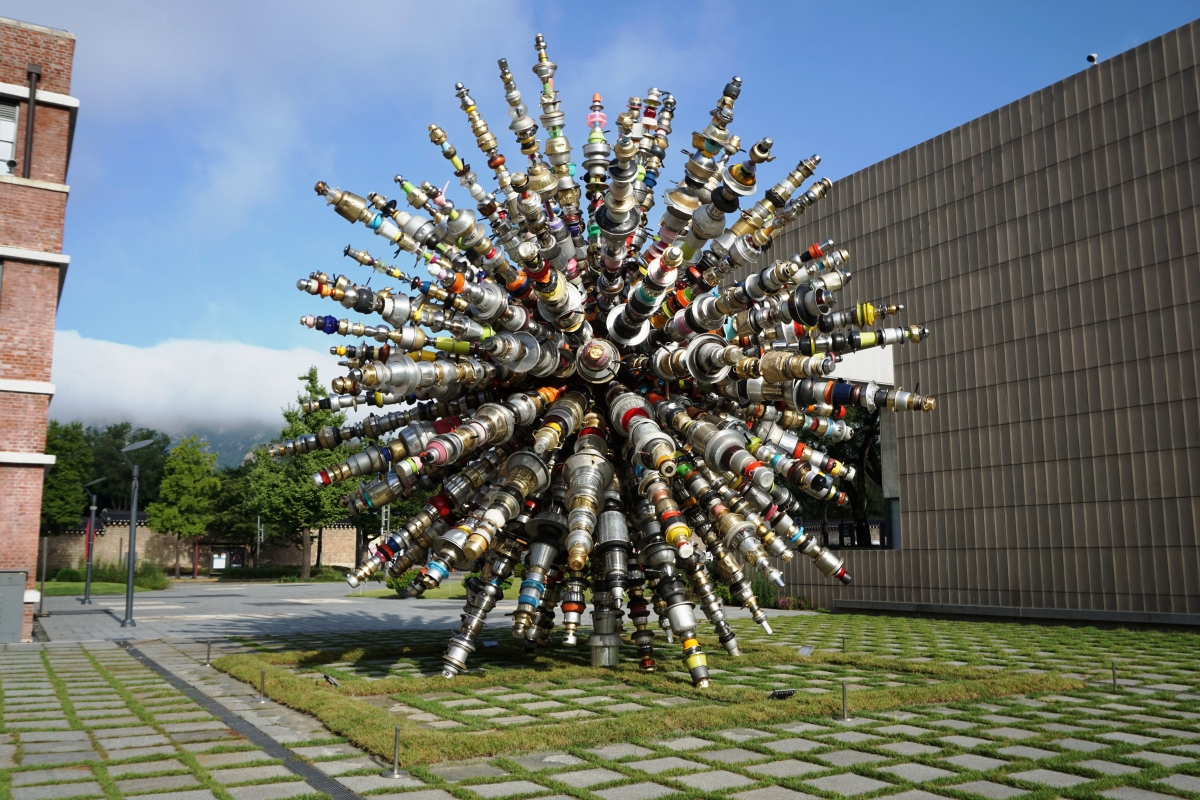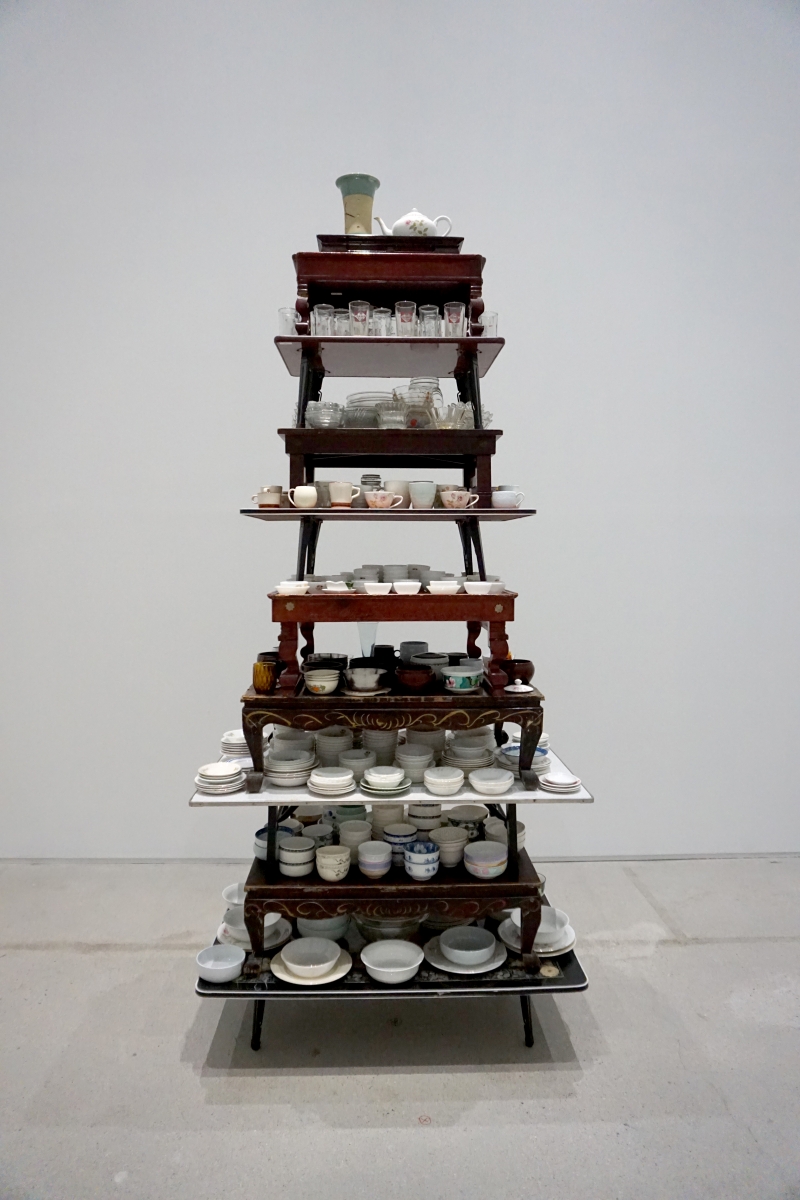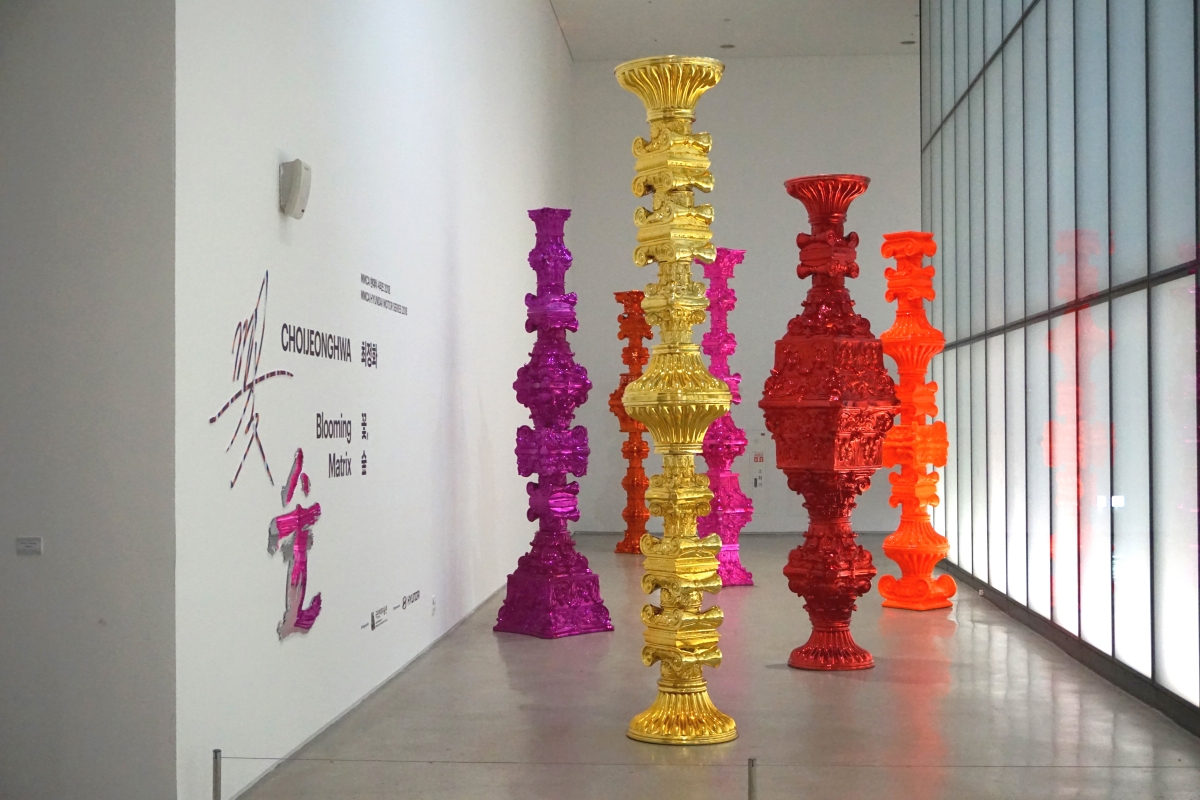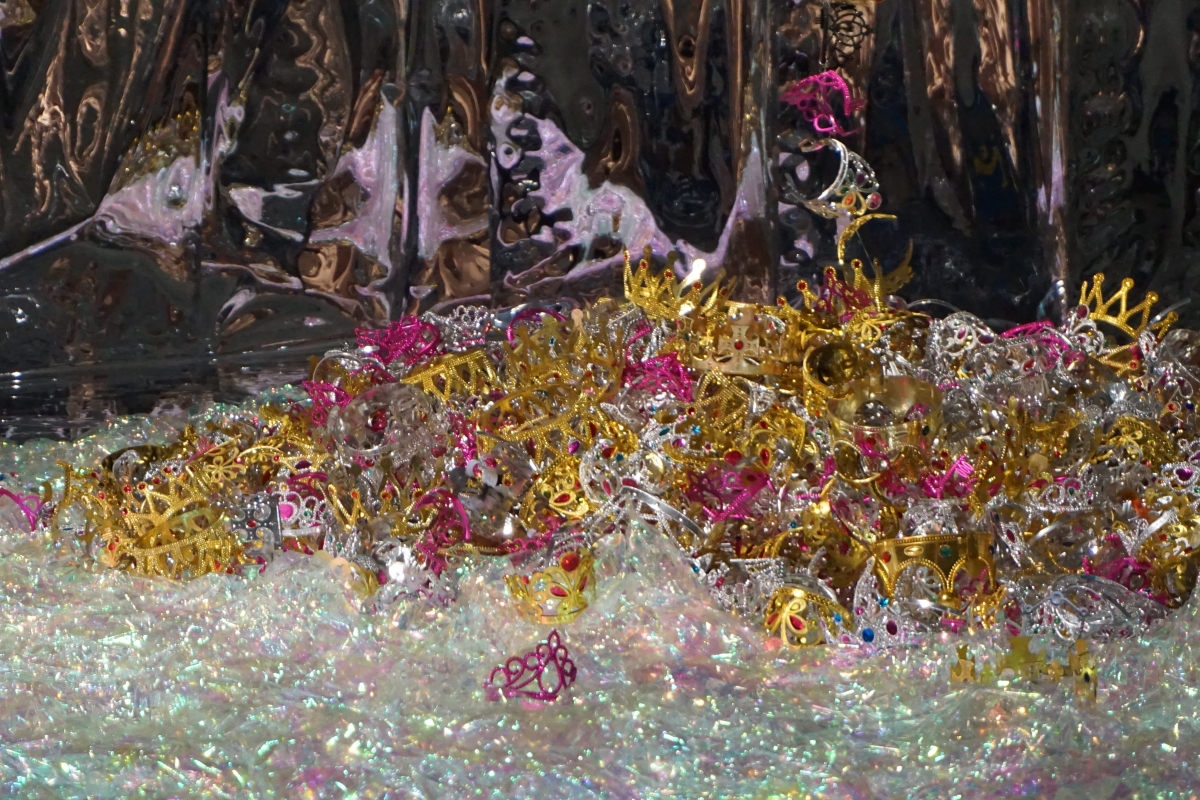‘MMCA Hyundai Motor Series 2018: CHOIJEONGHWA – Blooming Matrix’
National Museum of Modern and Contemporary Art, Seoul
Sep. 5, 2018 – Feb. 10, 2019

Choi Jeonghwa, Dandelion, Used Kitchenware, steel structure, 9Ø, 2018
Kim Geumyoung (Kim): Many people call the artist Choi Jeonghwa an ‘alchemist of plastic’.
Choi Jeonghwa (Choi): I like the word alchemy, but I do not really care what I am called. There are so many names, such as scientist, artist and mathematician. All of them act as intermediaries to communicate stories to the world and to connect people’s minds. This role is crucial.
Kim: Do you think your works attracted more attention than usual due to increasing awareness of the problem with plastics in the world?
Choi: Maybe, but the problems with plastic are not limited to today. It is a phenomenon that has arisen from the fact that plastic has not been respected in the past or the present. Plastics are made of materials derived from petroleum, that is, part of nature that comes from nature. It was regarded only as an artificial chemical material and poorly treated. Now people are beginning to realise that.
Kim: Are you using plastic to arouse people’s attention?
Choi: It is about attitude rather than attention. In the early 1990s, I was impressed by the attitudes of ladies who treated artificial and real flowers with the same attitude in everyday life. I looked at the attitude of respect for all, without comparing or excluding any object from the view of the ladies who put the artificial and real flowers in the flowerpot and hung the fruit. I felt that we should learn this attitude from them and look at the objects around us with new eyes. At that time, it was common to see things made of plastic in a house, such as colanders and cups, and naturally I began to use
these plastics to bring out these stories.

Choi Jeonghwa, A Feast of Flower, Used kitchenware, 290(h) × 75.5(w) × 122(d)cm, 2015
Kim: You have been using things that are not often used as art materials, such as pig heads, sweets for memorial services, and artificial flowers, and all this as well as plastic. At present, there is a lot of room to acknowledge the diversity of arts, but it seems that many of your choices appeared strange when you first presented your work?
Choi: Yes. Many people saw the work and asked, ‘What is this?’ But art is a process of asking questions, not answers. ‘Is it art?’, ‘Is this really art?’ The process of exchanging questions and stories is essential. Now I feel that people’s eyes have changed a lot. I think it is because there has been a lot of talk about the past.
Kim: You conducted a public art project ‘Gather Together’, creating a large installation work Dandelion consisting of over 7,000 dishes. Since March, you have been donating household goods directly from citizens of Seoul, Busan and Daegu. It seems to have been a complicated process?
Choi: This project has been steadily running for quite some time. I had the opportunity to start the project. When I saw a photo of a chair that remodelled a plastic chair without legs and a wooden chair without a backrest bound with strings, I was struck by a huge impression. It is the chair that has had a significant impact on my life. Each chair was broken, but two chairs gathered together
into one finished chair, and another story began here. Art should also be this way. People who are scattered want to gather and talk in one place. I gathered dishes to prepare that place. It is common to use tableware in any house across the ages and in all countries of the world. People sit around, have a meal and chat amiably. So the tableware contained the hearts of many people. I collected dishes that are written each person’s story and made Dandelion by combining them and the ones I gathered from junk shops. It isn’t easy but necessary.
Kim: I think you are able to make a variety of shapes with your tableware. Why is it a flower?
Choi: There is an impressive passage in the Nightfall of poet Che Hoki. ‘At nightfall when the Sun brightly rolls like an insect, the world is an inside of a flower’. A poet took notice of not only the form of the flower, but the mind that is embedded in it. I wanted to bloom in people’s minds. As the seeds germinate and the flowers burst into life, I hoped that the stories of the people would flourish in the museum. For example, people often give flowers when they convey what is in their hearts. You don’t have to think too hard. You don’t have to see it as a flower. Some people said Dandelion looks like a comet or a spaceship. You can see what you want to see.
Kim: Thanks to Dandelion, the museum yard has turned into a tourist attraction. Today, people took a lot of commemorative photos in front of it.
Choi: It’s what I wanted. I also call myself a ‘digital artist’. The work itself is done in an analogue way, but the people who have seen my works go back with their own memories and share the story in the digital world through social network services and spread it steadily. It is like a kind of a new story blooms again when people look at the flowers with many dishes that keep numerous stories. So, Dandelion is also a ‘digital blast furnace’ that dissolves a lot of ideas. I also refer to my work as Bibimbap or melting pot. There was a lot of stuff in it, but
none is separated and mixed in harmony.

Choi Jeonghwa, Present of Century, Steel structure, FRP, chrome coating, Dimension variable, 2016
Kim: If there is a huge flower in the museum yard, there is a lush forest inside the museum. Especially impressive is space where Blooming Matrix is made up of 146 flower towers made of household goods like Dandelion. When I walk down the road in the middle of the bright and dark exhibition hall, the shadows of the flower tower appear like drawings.
Choi: When I prepared this exhibition, I paid particular attention to the spatial composition and the visitor circulation. The exhibition space is a place where the material and light world gather. The flower tower seen from the front is three-dimensional, but if you walk on the road behind the tower when a dark change begins, the shadow of the tower appears, and the three-dimensional flower tower is reduced to a flat drawing. It displays not only the front view of the work that we have always seen, but also the back and the profile that we have not seen before, and transforms the ordinary museum space into a new space. I called this road ‘the way of meditation’. I didn’t want to show only one side. Light and darkness exist because of each other, and there is brilliance in uselessness, silence sometimes screams, and life and death are circulating. I intended for visitors to have as many different experiences as possible while seeing the exhibition through brightness and darkness, silence and sound, and covering the solemn walls of the museum with familiar wallpapers.

Choi Jeonghwa, Young Flower, Plastic crown, steel structure, Dimension variable, 2016 - 2018
Kim: The common point found in your work is the method of arrangement. I can see it from the tower of dining tables, A Feast of Flower which is made of rice bowls, Young Flower of children’s plastic crowns, the Present of Century which idea comes from the arrangement of wedding halls, and Grand Flower made of washboards. You carefully stacked objects. Not only these works, but there are also many that have stacked many materials up in a recombinant manner. What does ‘to stack up’ mean to you?
Choi: Every upright is stacked up. Light and materials are the same. I gathered and stacked up the hearts as a work. In the past, it was able to see mothers make wishes with a bowl of water on the wood-burning stove. They accumulate in their minds, hoping that their aspirations will reach into heaven. Even today, there are towers of all religions, and it is common for people to build a tower with small stones when they climb a mountain. From primitive times to the present, people have strenghtened their minds through the act of building. ‘Stacking up’ in my work is like the road to the entrance to heaven.
Kim: However, piling up means that it is going to support the one below.
Choi: Oh, It can be understood that way. I am happy to hear new comments. I want to hear as many comments as possible about my work. When my exhibitions open, I go to the exhibition gallery whenever I have the time and ask the people who manage the museum and docents how the audience reacted. When visitors sometimes come and talk to me, I am so thrilled.
Kim: What are the most memorable comments regarding this exhibition?
Choi: Everyone is my teacher. What I especially remember is the phrase, ‘catching eyes, hands, and hearts’. It means that people see the works with eyes, want to feel with hands, and that it touched their hearts. I was amazed to hear this. It is the audience who completes the work, I only prepare the place. I want to show the world as ‘different’ instead of ‘wrong’, and I hope these ‘other stories’ are respected. Many people are shrinking from what they see in the exhibition, but there is no wrong answer when it comes to the feelings you have while looking at artworks. For example, when you see Dandelion, it is important to be free to express opinions such as ‘It is the same bowl as in my house’ or ‘I like this one better’. It is like building a monument of your own. My aim in this exhibition is conversations among people. As trees gathered and become forests, when people meet, they also can become forests.
Kim: I hope that Dandelion really flies around like the real dandelion seeds and makes a new flower.
Choi: That is what I really hope. When I explain my work, I say ‘your heart is my heart’. I hope this desire will reach more people through the Dandelion seeds.





